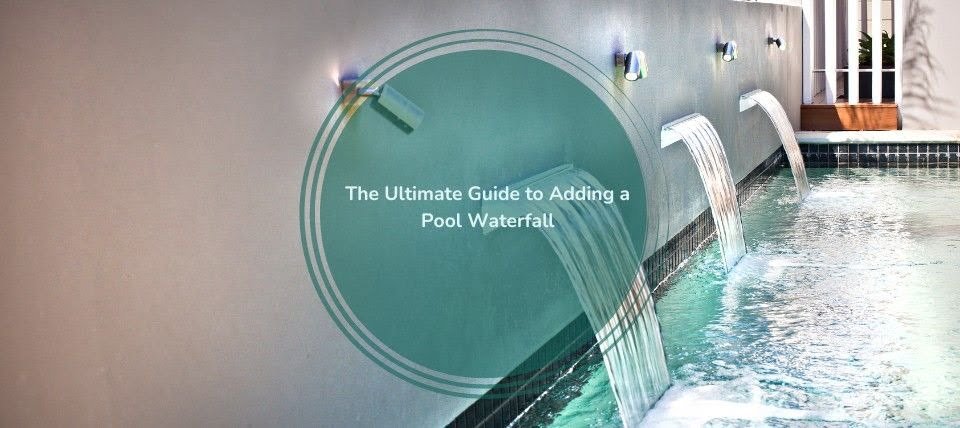Adding a pool waterfall can transform your swimming pool into a serene and luxurious retreat. The soothing sound of cascading water, combined with the visual appeal of a waterfall, creates a relaxing and inviting atmosphere. In this comprehensive guide, we’ll explore the benefits of pool waterfalls and the various design options available to enhance your backyard oasis.
Why Add a Pool Waterfall?
Pool waterfalls offer numerous benefits that go beyond aesthetics. Here are some compelling reasons to consider adding a waterfall to your pool:
- Enhanced Aesthetic Appeal: A pool waterfall serves as a stunning focal point, adding a touch of elegance and sophistication to your pool area. The movement and sound of flowing water create a dynamic and visually appealing environment.
- Soothing Ambiance: The gentle sound of cascading water has a calming effect, helping to reduce stress and promote relaxation. A pool waterfall can create a tranquil retreat where you can unwind and enjoy the peaceful ambiance.
- Improved Water Circulation: Pool waterfalls contribute to better water circulation, which helps to distribute chemicals more evenly and maintain cleaner, clearer water. This can reduce the need for maintenance and improve the overall health of your pool.
- Increased Property Value: A well-designed pool waterfall can significantly enhance the value of your property. It adds a luxurious feature that potential buyers may find attractive, making your home stand out in the real estate market.
- Customizable Designs: Pool waterfalls come in various styles and sizes, allowing you to customize the design to match your personal taste and the overall theme of your backyard. From natural rock formations to modern architectural designs, the possibilities are endless.
Types of Pool Waterfalls
There are several types of pool waterfalls to choose from, each offering unique features and aesthetic qualities. Here are some popular options:
Natural Rock Waterfalls
Natural rock waterfalls mimic the look of a natural stream or waterfall. They are constructed using real or artificial rocks, creating a rustic and organic appearance. These waterfalls blend seamlessly with natural landscapes and can be designed to suit various pool sizes and shapes.
Sheet Waterfalls
Sheet waterfalls produce a continuous sheet of water that flows evenly from a narrow ledge. This design creates a sleek and modern look, making it a popular choice for contemporary pools. Sheet waterfalls can be installed on pool walls, overhangs, or raised structures.
Spillover Spas
Spillover spas are a combination of a hot tub and a waterfall. The spa is elevated above the pool, and water spills over its edge into the pool below. This design provides the benefits of both a relaxing spa and a beautiful waterfall, adding both functionality and visual appeal.
Rain Curtains
Rain curtains create a gentle, rain-like effect by allowing water to flow through a series of small holes or nozzles. This design is ideal for creating a serene and calming atmosphere. Rain curtains can be installed on pergolas, overhangs, or custom-built structures.
Grottos
Grottos are cave-like structures that house a waterfall. They provide a secluded and intimate space within your pool, offering a sense of adventure and privacy. Grottos can be designed with natural rock formations, adding a touch of mystery and allure to your pool.
Cascades
Cascades feature multiple tiers of water flowing from one level to the next, creating a cascading effect. This design can be achieved using rocks, tiles, or other materials, and is ideal for creating a dramatic and eye-catching feature in your pool.
Design Considerations for Pool Waterfalls
When designing a pool waterfall, several factors should be considered to ensure a successful and harmonious integration with your pool:
Style and Theme
Choose a waterfall design that complements the overall style and theme of your pool and backyard. For example, natural rock waterfalls are ideal for rustic or tropical themes, while sheet waterfalls suit modern and minimalist designs.
Location and Placement
The location of your waterfall is crucial for both aesthetics and functionality. Consider placing the waterfall in a prominent spot where it can be easily seen and enjoyed. Ensure that the placement does not obstruct swimming areas or create safety hazards.
Size and Scale
The size and scale of the waterfall should be proportionate to your pool. A large waterfall may overpower a small pool, while a small waterfall may not have the desired impact in a large pool. Work with a professional to determine the appropriate size for your space.
Materials
Select materials that are durable and weather-resistant. Natural stone, concrete, and high-quality tiles are popular choices for pool waterfalls. Ensure that the materials blend well with the surrounding landscape and pool design.
Water Flow and Sound
Consider the flow and sound of the water when designing your waterfall. The flow rate should be adjustable to create the desired effect, whether it’s a gentle trickle or a powerful cascade. The sound of the water should be soothing and not overwhelming.
Lighting
Incorporate lighting into your waterfall design to enhance its beauty and visibility at night. LED lights can be used to highlight the flowing water, creating a mesmerizing and magical effect. Underwater lights can also add depth and drama to the waterfall.
Installation and Maintenance
Installing a pool waterfall requires professional expertise to ensure proper integration with your pool’s plumbing and filtration systems. Here are some key steps involved in the installation process:
- Planning and Design: Work with a professional to plan the design and layout of your waterfall. Consider factors such as water source, flow rate, and structural support.
- Excavation and Construction: The installation process may involve excavation and construction to create the necessary foundations and structures for the waterfall.
- Plumbing and Electrical: Proper plumbing and electrical work are essential for the functioning of the waterfall. Ensure that all connections are secure and comply with safety standards.
- Finishing Touches: Once the main structure is in place, add finishing touches such as rocks, tiles, or decorative elements to complete the look.
- Testing and Adjustment: Test the waterfall to ensure that it operates smoothly and adjust the flow rate as needed to achieve the desired effect.
Maintenance of a pool waterfall involves regular cleaning and inspection to keep it in optimal condition. Remove debris, check for leaks, and ensure that the plumbing and filtration systems are functioning properly. Regular maintenance helps to prolong the lifespan of the waterfall and maintain its visual appeal.
Conclusion
Adding a pool waterfall to your swimming pool can enhance its beauty, functionality, and value. Whether you opt for a natural rock waterfall, a sleek sheet waterfall, or a luxurious spillover spa, the benefits of incorporating a waterfall are undeniable. By considering factors such as style, location, and materials, you can create a stunning and tranquil oasis in your backyard. Work with professionals to ensure proper installation and maintenance, and enjoy the soothing sounds and visual allure of your new pool waterfall for years to come.




